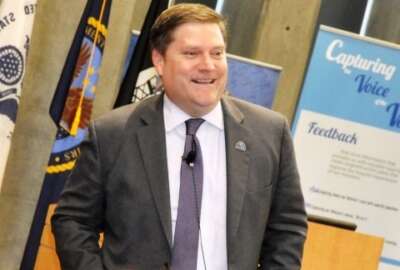
To be successful, new VA CIO must listen, do research and be humble
Before James Gfrerer, VA chief information officer, answers the ranking member of the Veterans Affairs Committee, he should meet with many of his stakeholders to...
The Senate confirmed James Gfrerer as the Department of Veterans Affairs’ assistant secretary and chief information officer just 17 days ago. Like most political appointees, he likely has been working at VA since he was nominated back in July.
But now his real work begins by figuring out how to manage 8,000 IT employees, another 8,000 contractors, hundreds of systems and an IT budget of almost $5 billion.
And Sen. Jon Tester (D-Mont.), ranking member of the Veterans Affairs Committee, wants to make sure Gfrerer knows lawmakers are watching.
Tester wrote to Gfrerer on Jan. 11 asking for a “comprehensive and prioritized list of VA IT projects.” Tester also wanted to see what metrics or rationale were used for prioritizing the projects.
“The operation of VA’s Office of Information and Technology has been under severe, well-deserved scrutiny in recent years,” Tester writes. “There is no doubt that insufficient resources, a chronic lack transparency and an inability to effectively prioritize countless competing objectives have led to serious questions about VA’s ability to meet the standard of technology necessary to serve our nation’s veterans.”
While Tester didn’t give Gfrerer a deadline to respond, there is no doubt that the legislator will not want to wait long for an answer.
So how can Gfrerer get his arms around the largest civilian agency’s technology projects, infrastructure and personnel?
Advice from former VA IT executives
Former VA technology executives say understanding the agency’s projects and programs and prioritizing them requires a whole lot of listening, a bit of research and a dash of humility.
“As quickly as possible, you have to get an understanding of the current state of technology. What is happening now? What is working and what is not? And he has to be willing to help the team understand sometimes you have to call it when a project is not working,” Laverne Council, the national managing principal for enterprise technology strategy and innovation for Grant Thornton, said in an interview with Federal News Network. “In technology, there will be things that were great ideas, but things change, opportunities change and technology changes every day. It could create different or new opportunities, and you have to have the kind of agility that allows you to say I’m changing the direction, and you have to be able to justify why. I’ve had to do those pivots. Those pivots help you gain credibility and bring change to the organization to provide speed to value.”

Council, who was the last politically appointed VA CIO, came in under similar circumstances as Gfrerer. Both started at the agency without a lot of federal experience and under a great deal of scrutiny by Congress and veterans to make technology services work better.
“I came from corporate America so I was used to working with C-suite executives and boards of directors. I understand the value of every stakeholder. My responsibility was to communicate before I was asked. I came up with a stakeholder list of all the people who need to know what’s going on,” she said. “I remember telling my folks that we are going up to the Hill and find out what they need to know. We will communicate in several ways by issuing an annual report, through meetings and updates and through the press. I had meetings with veteran service organizations. I met with every VSO, lawmakers, internal stakeholders including the inspector general every four-to-six weeks. All of this allows you to get the momentum and have the agility you need because we were constantly pushing information about what they needed to know.”
Another former VA IT executive, who requested anonymity because they didn’t get permission to speak to the press from their current company, said creating the relationship with internal customers from the Veterans Benefits Administration, Veterans Health Administration and the National Cemetery Administration is maybe more important than with the agency’s external customers.
“[Gfrerer] doesn’t need to go to every single hospital, but should go to different size ones to see challenges of the electronic health record or with the infrastructure as we well as some of things they are dealing with and the frustrations of people at front lines so you see their pain points,” said the former VA executive. “The more he can understand the business side, the more credibility he will have. That also will help him work with the undersecretaries better. Anything he does needs to be done with the other leaders in the department. There is only so much you can do to improve hospital IT outside of the leadership of VHA. So he needs to develop those relationships at the business level.”
The former executive added that knowing the key contractors also is important because of VA’s reliance on vendors.
“There are a couple of hundred contractors so you have to get to know them,” the executive said. “VA is an incredibly complex animal with a vast budget and an even larger technical debt. It’s an awful lot to absorb.”
Don’t manage by IG fires
And that need to absorb so much is why former VA officials said Gfrerer needs a dash of humility.
Sean Kelley, the former VA deputy CIO and now executive vice president of development and IT operations at Unissant, said he has to be careful not to manage by IG report or whatever fire is burning today.
Kelley said any new CIO, after understanding the lay of the land, must come up with a handful of changes he believes he can make in two years.
“He has to decide on what will impact veterans the greatest in terms of benefiting their lives as he looks at things,” Kelley said. “He has to understand and stop the pain points, answer congressional questions and establish the relationships across VA and VSOs.”
Related Stories

Can VA’s new CIO, accountability director finally spark a long-awaited culture change?
“He needs to assess the situation for each program and give them an open assessment,” she said. “It’s one thing to say to Congress ‘here is a program,’ but another to say, ‘here is the reality of what we will deliver and where I need your help.’ I can’t remember a time when I didn’t ask Congress for something and gave them something as well.”
Council and others say this is why Tester’s letter is more than just expected oversight, but the lawmaker reaching his hand out to say “I’m on your side, if you want to work together.”
“When I looked at Tester’s letter, I didn’t think it was a negative, but really a call for transparency,” Council said. “Sen. Tester was asking relevant questions that require transparency, an agile project management office, and the ability to guarantee a consistent flow of information using metrics that matter.”
The former VA IT executive added a lot of what Tester was asking was the blocking and tackling of the agency’s infrastructure and technical debt challenge.
“I think what Sen. Tester is looking for is an honest assessment of what it will take to modernize VA’s infrastructure so things are not falling apart which will increasingly happen,” the source said. “You understand it’s a difficult system that is not set up for success. It’s also easy to go in there and say ‘people are idiots and I’m going to get my own team in there.’ But you actually find out there are a lot of good people at VA and it’s just the scale of the agency that is so challenging. It’s very cliché to blame everything on the outdated architecture and infrastructure, some of which is 50 years old and falling apart. But you can’t snap your fingers and replace things. There are a lot of dependencies. It’s a very overwhelming system that you need to get arms around and understand where to focus your energy and time on to make a difference.”
Read more of the Reporter’s Notebook
Copyright © 2025 Federal News Network. All rights reserved. This website is not intended for users located within the European Economic Area.
Jason Miller is executive editor of Federal News Network and directs news coverage on the people, policy and programs of the federal government.
Follow @jmillerWFED




